Posts Tagged dearborn
Remembering Mose Nowland (1934-2021)

Mose Nowland, with wife Marcia and daughter Suzanne, at The Henry Ford in June 2021.
The Henry Ford lost a dear friend and a treasured colleague on August 13, 2021, with the passing of Mose Nowland. When he joined our Conservation Department as a volunteer in 2012, Mose had just concluded a magnificent 57-year career with Ford Motor Company—most of it in the company’s racing program—and he was eager for something to keep himself occupied in retirement. We soon discovered that “retire” was just about the only thing that Mose didn’t know how to do.
To fans of Ford Performance, Mose was a legendary figure. He joined the Blue Oval in 1955 and, after a brief pause for military service, he spent most of the next six decades building racing engines. Mose led work on the double overhead cam V-8 that powered Jim Clark to his Indianapolis 500 win with the 1965 Lotus-Ford. Mose was on the team behind the big 427 V-8 that gave Ford its historic wins over Ferrari at Le Mans—first with the GT40 Mark II in 1966 and then again with the Mark IV in 1967. And Mose was there in the 1980s when Ford returned to NASCAR and earned checkered flags and championships with top drivers like Davey Allison and Bill Elliott.
Mose with one of his creations during Ford’s Total Performance heyday.
Following his retirement, Mose transitioned gracefully into the role of elder statesman, becoming one of the last remaining participants from Ford’s glory years in the “Total Performance” 1960s. Museums and private collectors sought him out with questions on engines and cars from that era, and he was always happy to share advice and insight. Mose’s expertise was exceeded only by his modesty. He never claimed any personal credit for Ford’s racing triumphs—he was just proud to have been part of a team that made motorsport history. Mose was able to see that history reach a wider audience with the success of the recent movie Ford v Ferrari.
Michigan, Dearborn, The Henry Ford staff, 21st century, 20th century, racing, race cars, philanthropy, Old Car Festival, Model Ts, Mark IV, making, in memoriam, Henry Ford Museum, Greenfield Village, Ford workers, Ford Motor Company, engines, engineering, collections care, cars, by Matt Anderson, #Behind The Scenes @ The Henry Ford
A Photographer’s Portrait: Rudy Ruzicska

Rudy Ruzicska working in The Henry Ford’s photographic studio on August 10, 2021. You can see Rudy's completed photos of this display cabinet, containing "Munyon's Homeopathic Remedies" dating from the late 19th or early 20th century, in our Digital Collections here.
1956 was a momentous year in history. President Dwight D. Eisenhower and Vice-President Richard M. Nixon were running for re-election. The Montgomery Bus Boycott had just started, inspired by Rosa Parks refusing to give up her seat the previous December. The Interstate Highway System was authorized. Elvis Presley had his first chart-topping hit with “Heartbreak Hotel.” There were no satellites in space, and the United States had only 48 states, since Alaska and Hawaii were still three years away from statehood. In the midst of all this, a fresh-faced young lad officially began a career at The Henry Ford. His name? Rudy Ruzicska.
Now, 65 years later, Rudy still works at The Henry Ford, expertly photographing our artifacts as part of our collections digitization process so we can share them with the world through our Digital Collections. If you see a photo of a three-dimensional artifact in our Digital Collections, chances are good that Rudy took it. His long career and deep expertise have been featured both on Detroit television news and on The Henry Ford’s Innovation Nation (watch those clips below). He even received a congratulations on his 65th work anniversary from Innovation Nation host Mo Rocca.
Continue Reading
Michigan, Dearborn, 21st century, 20th century, The Henry Ford staff, photography, photographs, digitization, by Tim Johnson, #Behind The Scenes @ The Henry Ford
Fair Lane: The Fords’ Private Railroad Car
 Fair Lane, Henry and Clara Ford’s private railroad car. / THF80274
Fair Lane, Henry and Clara Ford’s private railroad car. / THF80274Fair Lane, the private Pullman railroad car built for and used by Henry and Clara Ford, turns 100 years old in 2021. It provides a fascinating window into business and pleasure travel for the wealthy in the early 20th century.
By 1920, the Fords found it increasingly difficult to travel with any degree of privacy. Henry, in particular, was widely recognized by the public. He’d been generating major headlines for a decade, whether for his victory against the Selden Patent, his achievements with mass production and worker compensation via the Five Dollar Day, or his misguided attempt to end World War I with the Peace Ship. The Fords could travel privately for shorter distances by automobile, and their yacht, Sialia, provided seclusion when traveling by water. But anytime they entered a railroad station, the couple was sure to be pestered by the public and hounded by reporters. Their solution was to commission a private railroad car for longer overland trips.
Private railroad cars are nearly as old as the railroad itself. America’s first common-carrier railroad, the Baltimore & Ohio, opened in 1830. Little more than ten years later, President John Tyler traveled by private railcar over the Camden & Amboy Railroad to dedicate Boston’s Bunker Hill Monument in 1843. Not surprisingly, railroad executives and officials were also early users of private railroad cars. Cornelius Vanderbilt, president of the New York Central Railroad, used a private car when traveling over his line, both for business and for pleasure. For a busy railroad manager, the private railcar served as a mobile workspace where business could be conducted at distant points on the railroad line, far from company headquarters.

Pullman cars on the First Transcontinental Railroad, circa 1870. / THF291330
Following the Civil War, the Pullman Palace Car Company earned a reputation for its opulent public passenger cars with comfortable sleeping accommodations. Company founder George Pullman designed a private railcar to similar high standards. Pullman named the car P.P.C.—his company’s initials—and used it when traveling with his family. Pullman enjoyed lending the car to other dignitaries, by which he could simultaneously impress VIP passengers and advertise his company. Eventually, Pullman began renting the car out to patrons who could afford the daily rate of $85 (more than $2,000 today).
Clara and Henry Ford ordered their private railroad car from the Pullman Company on February 18, 1920. They hoped to have it delivered by that September, for a planned trip to inspect properties Henry had recently purchased in Michigan’s Upper Peninsula. But delays pushed the car’s actual delivery date back by about nine months. Some of those delays were due to changes to the car’s interior. Clara designed the interior spaces, working with Sidney Houghton of London, who had earlier provided the same service for the Fords’ yacht.
The finished railroad car was delivered on June 23, 1921. The Fords named it Fair Lane—the same name they’d given to their estate in Dearborn, Michigan. (Fair Lane was the area in County Cork, Ireland, where Mr. Ford’s grandfather was born.) The final bill for the railcar came to $159,000 (about $2.3 million today). The Fords paid 25 percent of that cost upon placing their order, a further 25 percent during construction, and the final 50 percent on delivery.
Surely the finished Fair Lane was worth the wait and expense. The car included accommodations for six passengers and sleeping quarters for two additional staff members. When traveling, Fair Lane typically was staffed by a porter to attend to the passengers’ needs and a cook to prepare meals.

Fair Lane’s lounge offered the best views of passing scenery. / THF186264
At the rear of the car, a comfortable lounge provided a spot to read, relax, or simply watch the passing scenery through the large windows. An open porch-like platform at the very rear of the car was particularly enjoyable at moderate train speeds. Typically, Fair Lane was coupled to the end of a train, meaning that the view from the platform would not be obstructed.

Bedrooms in Fair Lane were cozy but comfortable. / THF186273
From the lounge, a narrow hallway ran most of the car’s length. Four bedrooms were located along the corridor. These rooms were cozy but comfortable. Each room had a bed, but berths could be unfolded from above to provide additional sleeping space if needed. Dressers and small desks rounded out the furnishings. Likewise, the bathrooms in Fair Lane were small but serviceable. Each one had hot and cold running water and a toilet. The master bath also included a shower.

Fair Lane’s passengers dined in this area. An on-board cook prepared meals to order. / THF186285
The dining area, near the front of the car, featured an extension table that comfortably seated six adults at one time. The chandelier, which hung directly above the table, was secured with guys that kept it from swaying as the car rolled down the railroad track. Built-in cabinets housed the car’s glassware and china. Clara Ford stocked Fair Lane with 144 various glasses, 169 pieces of silverware, and 230 crockery items. Wood posts and rails kept things from sliding around or falling out of the cabinets.

The car’s kitchen was small but sufficient for elaborate meals. / THF186289
Logically, the kitchen was located just in front of the dining room. Finished in stainless steel, the kitchen included an oven, a stovetop, a sink, and numerous additional cabinets. Food and supplies were loaded through the door at the car’s front end, so as not to disturb the riders farther back in the car. Staff quarters were located in the front of the car too. Compared with the other bedrooms, the staff room was sparse and utilitarian.
Using Fair Lane was not like driving a limousine or flying a private airplane. The railcar’s travels had to be coordinated with the various host railroads that operated America’s 250,000-mile rail network. Usually, Fair Lane was coupled to a regularly scheduled passenger train. The fee for pulling the private car was equivalent to 25 standard passenger tickets. One standard ticket on a train from Detroit to New York City in the early 1920s cost around $30, meaning the Fair Lane fee worked out to about $750 (around $10,000 today). If Fair Lane required a special movement—that is, if it was moved with a dedicated locomotive and not as a part of a regular train—then the fee jumped to the equivalent of 125 standard tickets.
The fee structure was different when Fair Lane moved over the Detroit, Toledo & Ironton Railroad. Henry Ford personally owned DT&I from 1920 to 1929. It was considered official railroad business when Mr. Ford used his private car on DT&I, so he did not need to pay a fare for himself. But he did pay fares for Fair Lane passengers who weren’t directly employed by DT&I.

Edsel and Eleanor Ford, Henry and Clara Ford, and Mina and Thomas Edison pose on the car’s rear platform about 1923. / THF97966
The Fords made more than 400 trips with Fair Lane in the two decades that they owned the car. Annual excursions took Henry and Clara Ford to their winter homes in Fort Myers, Florida, or Richmond Hill, Georgia. Likewise, Edsel and Eleanor Ford, Henry and Clara’s son and daughter-in-law, occasionally used Fair Lane to visit their own vacation home in Seal Harbor, Maine. The Fords hosted several special guests on the car too. Presidents Warren Harding and Calvin Coolidge both spent time on the car, as did entertainer and humorist Will Rogers. Not surprisingly, Thomas and Mina Edison—among Henry and Clara Ford’s closest friends—also traveled aboard Fair Lane.
Clara Ford enjoyed trips to New York City, where she could visit friends or patronize specialty boutiques and department stores. Fair Lane could be coupled to direct Detroit–New York trains like New York Central’s Wolverine or Detroiter. Both trains arrived at the famous Grand Central Terminal in the heart of Manhattan. In 1922, an overnight run from the Motor City to the Big Apple on the Wolverine took 16 hours.
Both Henry Ford and Edsel Ford used Fair Lane when traveling on Ford Motor Company business. Chicago, New York, Boston, and Washington, D.C., were all frequent destinations on these trips. Of course, they’d travel to distant Ford Motor Company properties too, including those previously mentioned holdings in Michigan’s Upper Peninsula.

Detroit’s Michigan Central Station, where most of Fair Lane’s journeys began and ended. / THF137923
Most of the car’s trips started and ended at Detroit’s Michigan Central Station, ten miles east of Dearborn. The large station had facilities to clean and stock Fair Lane, and crews to switch the car onto regular passenger trains. Michigan Central was a New York Central subsidiary, and New York Central trains provided direct service from Detroit to Chicago, New York, Boston, and many places in between. For longer trips, New York Central coordinated with additional railroad lines to transfer Fair Lane to other trains at connecting points, making the trip as seamless as possible for the Fords.
When Fair Lane wasn’t traveling out on a railroad, the car was stored in a shed built for it near Henry Ford’s flour mill on Oakwood Boulevard in Dearborn. The shed was just west of Dearborn’s present John D. Dingell Transit Center, where Amtrak trains stop today.
The Fords considered updating or replacing Fair Lane at different times. As early as March 1923, Ernest Liebold, Henry Ford’s personal secretary, wrote to the Pullman Company to inquire about building a larger car surpassing Fair Lane’s 82-foot length. Whatever Pullman’s reply, Ford did not place a new order. Twelve years later, Edsel Ford wrote to Pullman to ask about adding air conditioning to Fair Lane. The company responded with an estimate of $12,000 for the upgrade. Apparently, the cost was high enough for the Fords to once again consider building an entirely new, larger private railcar. The Pullman Company prepared a set of drawings for review but, once again, no order was placed.

Fair Lane in November 1942, at the end of its time with the Fords. / THF148020
By the early 1940s, Fair Lane was aging and in need of either significant repairs or outright replacement. Henry and Clara Ford were aging too, and weren’t traveling quite as much as they had in earlier years. On top of this, the United States joined World War II following the attack on Pearl Harbor in December 1941. Wartime brought with it restrictions on materials, manufacturing, and travel—each on its own enough to sidetrack further work on Fair Lane. Somewhat reluctantly, Henry and Clara Ford sold their private railroad car in November 1942.
The St. Louis Southwestern Railway purchased Fair Lane from the Fords for $25,000. The company used the car for railroad business, carrying executives on its lines concentrated in Arkansas and Texas. In 1972, St. Louis Southwestern donated Fair Lane to the Cherokee National Historical Society. The organization used the car as an office space for the Cherokee Nation in Tahlequah, Oklahoma.
Richard and Linda Kughn purchased Fair Lane in 1982. They moved it to Tucson, Arizona, and began a four-year project to restore the car to its original Ford-era appearance. At the same time, they updated Fair Lane with modern mechanical, electrical, and climate-control systems. The Kughns enjoyed the refurbished railcar for several years before gifting it to The Henry Ford in 1996. Today Fair Lane is back in Dearborn—a testament to the golden age of railroad travel, as experienced by those with gilded budgets.
Matt Anderson is Curator of Transportation at The Henry Ford.
Additional Readings:
- 1924 Railroad Refrigerator Car, Used by Fruit Growers Express
- Ingersoll-Rand Number 90 Diesel-Electric Locomotive, 1926
- Allegheny Locomotive: Can-Do Experience
- Revolution on Rails: Refrigerated Box Cars
21st century, 20th century, travel, railroads, Michigan, Henry Ford Museum, Henry Ford, Fair Lane railcar, Detroit, Dearborn, Clara Ford, by Matt Anderson
Henry Ford: Case Study of an Innovator
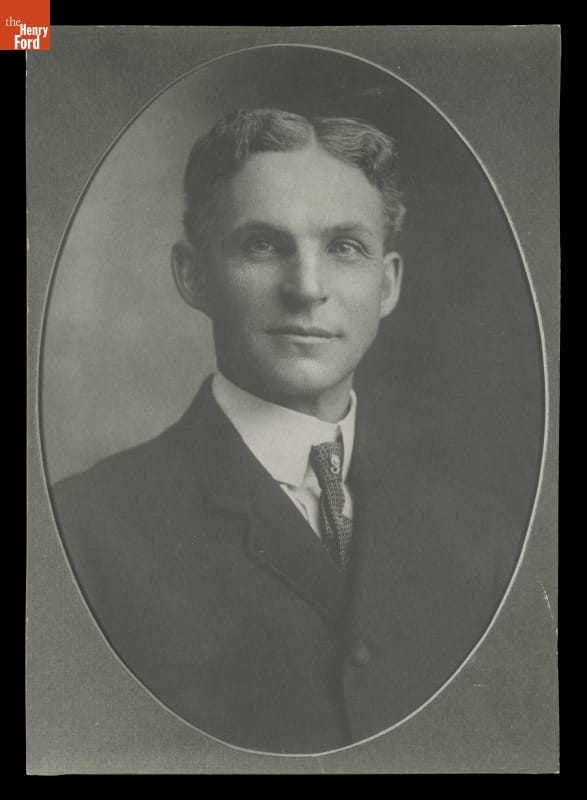
Henry Ford’s first official Ford Motor Company portrait, 1904. / THF97952
Henry Ford did not invent the automobile. But more than any other single individual, he was responsible for transforming the automobile from an invention of unknown utility into an innovation that profoundly shaped the 20th century and continues to affect the 21st. His work at Ford Motor Company revolutionized the automotive industry, setting new standards for production and accessibility.
Innovators change things. They take new ideas—sometimes their own, sometimes other people’s—and develop and promote those ideas until they become an accepted part of daily life. Innovation requires self-confidence, a taste for taking risks, leadership ability, and a vision of what the future should be. Henry Ford had all these characteristics, but it took him many years to develop all of them fully.
Portrait of the Innovator as a Young Man
Ford’s beginnings were perfectly ordinary. He was born on his father’s farm in what is now Dearborn, Michigan, on July 30, 1863. At this time, most Americans were born on farms, and most looked forward to being farmers themselves. Early on, Ford demonstrated some of the characteristics that would make him successful. In his family, he became infamous for taking apart his siblings’ toys as well as his own. He organized other boys to build rudimentary waterwheels and steam engines. He learned about full-size steam engines by becoming acquainted with the engines’ operators and pestering them with questions. He taught himself to fix watches and used the watches themselves as textbooks to learn the basics of machine design. Thus, at an early age, Ford demonstrated curiosity, self-confidence, mechanical ability, the capacity for leadership, and a preference for learning by trial and error. These characteristics would become the foundation of his whole career.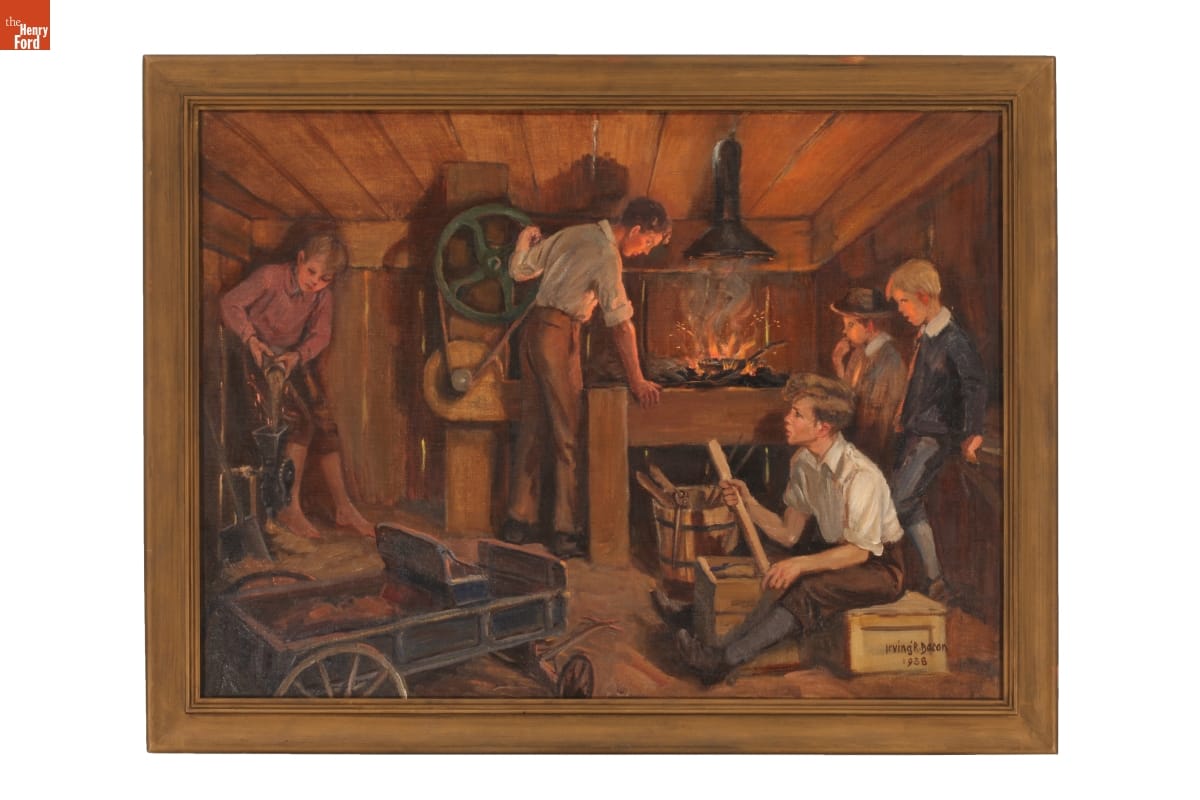
Artist Irving Bacon depicted Henry Ford in his first workshop, along with friends, in this 1938 painting. / THF152920
Ford could simply have followed in his father’s footsteps and become a farmer. But young Henry was fascinated by machines and was willing to take risks to pursue that fascination. In 1879, he left the farm to become an apprentice at a machine shop in Detroit. Over the next few years, he held jobs at several places, sometimes moving when he thought he could learn more somewhere else. He returned home in 1882 but did little farming. Instead, he operated and serviced portable steam engines used by farmers, occasionally worked in factories in Detroit, and cut and sold timber from 40 acres of his father’s land.
By now, Ford was demonstrating another characteristic—a preference for working on his own rather than for somebody else. In 1888, Ford married Clara Bryant, and in 1891 they moved to Detroit. Ford had taken a job as night engineer for the Edison Electric Illuminating Company—another risk on his part, because he did not know a great deal about electricity at this point. He took the job in part as an opportunity to learn.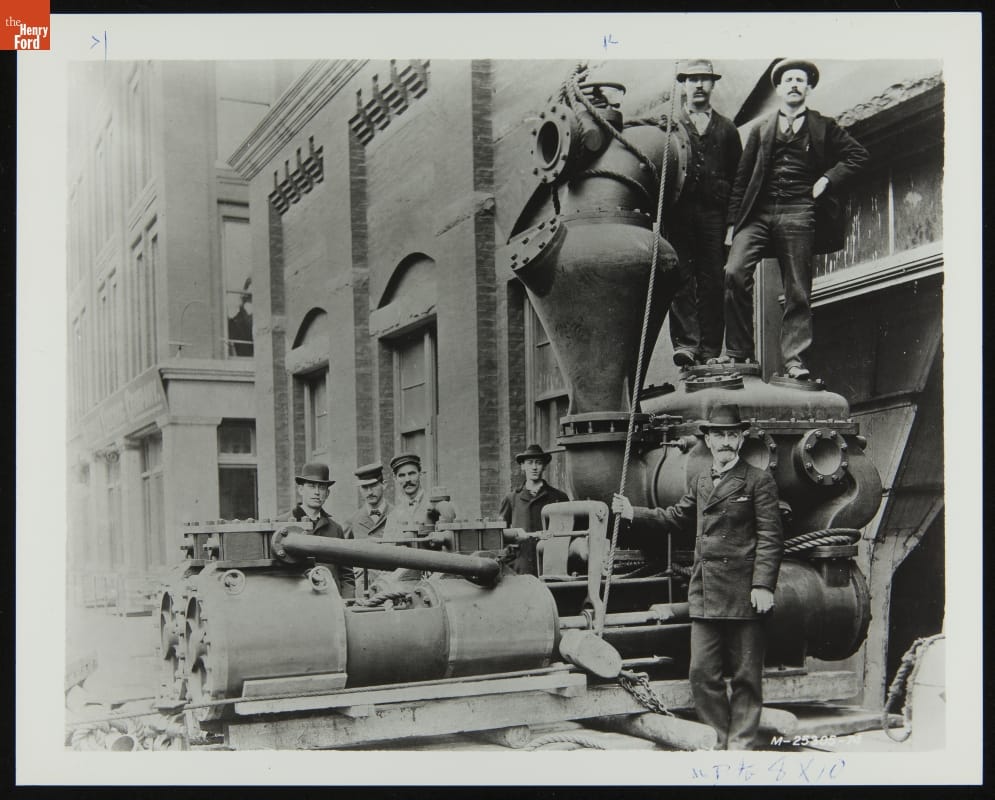
Henry Ford (third from left, in white coat) with other employees at Edison Illuminating Company Plant, November 1895. / THF244633
Early Automotive Experiments: Failure and Then Success
Henry was a skilled student, and by 1896 had risen to chief engineer of the Illuminating Company. But he had other interests. He became one of the scores of other people working in barns and small shops trying to make horseless carriages. Ford read about these other efforts in magazines, copying some of the ideas and adding some of his own, and convinced a small group of friends and colleagues to help him. This resulted in his first primitive automobile, the Quadricycle, completed in 1896. A second, more sophisticated car followed in 1898. These early experiments laid the groundwork for his future endeavors in the automotive industry.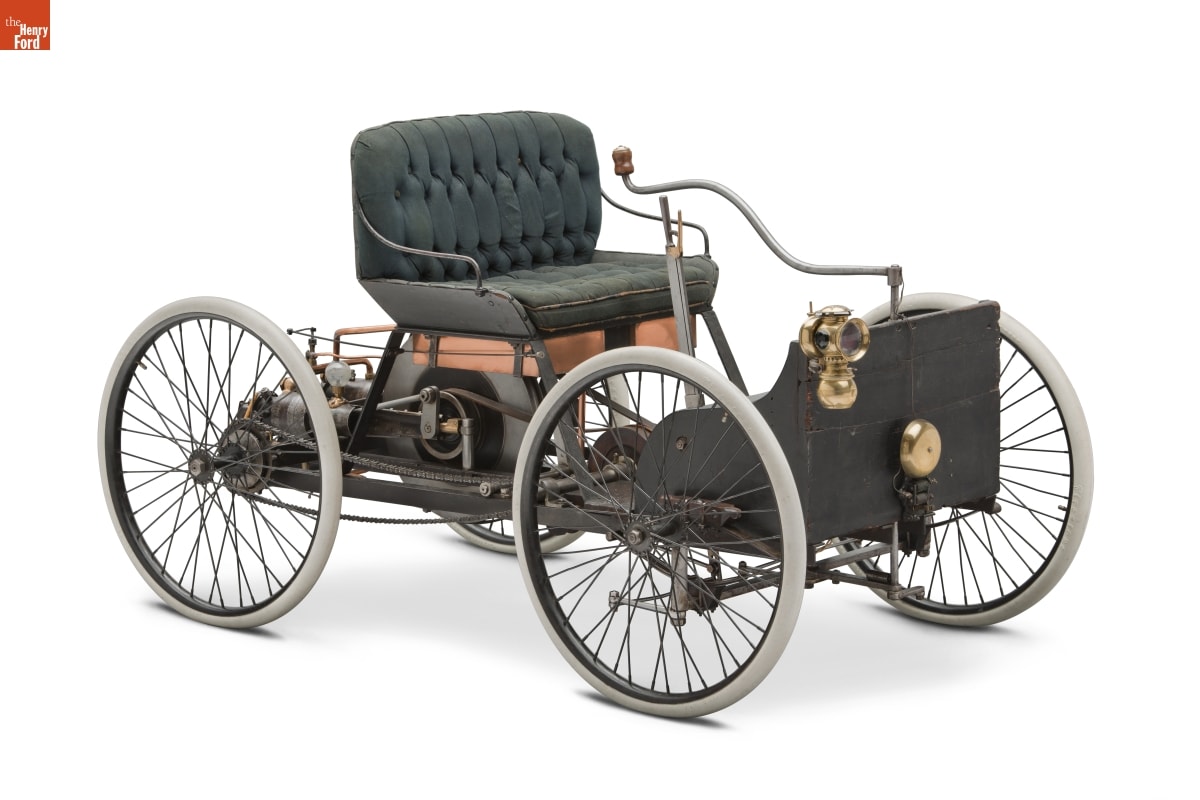
Henry Ford’s 1896 Quadricycle Runabout, the first car he built. / THF90760
Ford now demonstrated one of his most important characteristics—the ability to articulate a vision and convince other people to sign on and help him achieve that vision. He convinced a group of businessmen to back him in the biggest risk of his life—starting a company to make horseless carriages. But Ford knew nothing about running a business, and learning by doing often involves failure. The new company failed, as did a second. His first venture, the Detroit Automobile Company, failed due to the poor quality of its vehicles. Ford tried again, this time with the Henry Ford Company. But disputes over the new company’s direction soon caused Ford and his investors to part ways.
To revive his fortunes, Ford took bigger risks, building and even driving a pair of racing cars. The success of these cars attracted additional financial backers, and on June 16, 1903, just before his 40th birthday, Henry incorporated his third automobile venture, the Ford Motor Company.
The early history of Ford Motor Company illustrates another of Henry Ford’s most valuable traits—his ability to identify and attract outstanding talent. He hired a core of young, highly competent people who would stay with him for years and make Ford Motor Company into one of the world’s great industrial enterprises. He hired a core of young, highly competent people who would stay with him for years, reshaping America’s automotive industry while building Ford Motor Company into one of the world’s great industrial enterprises.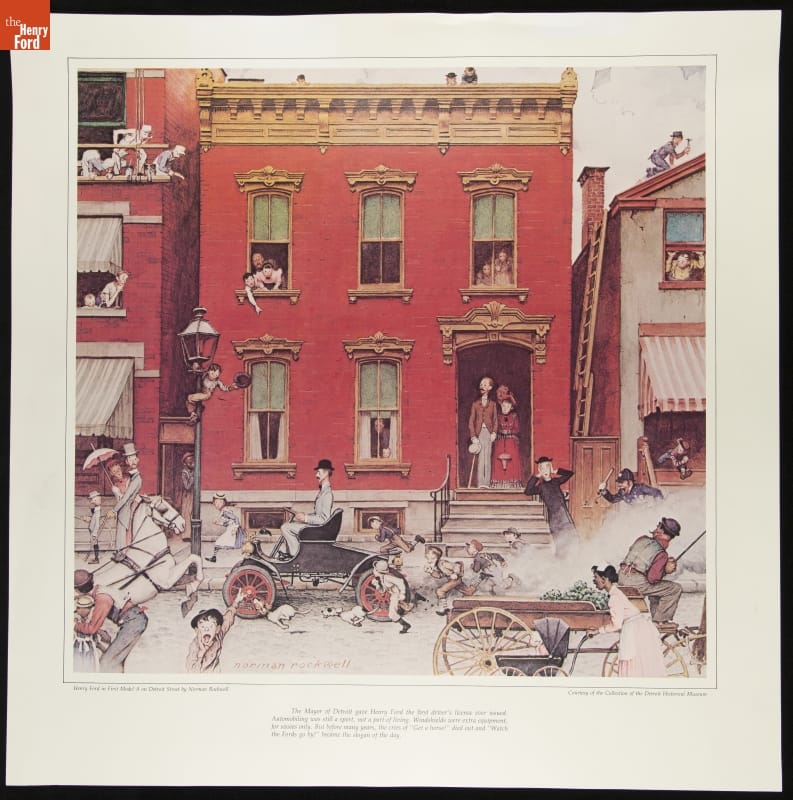
Print of Norman Rockwell's painting, "Henry Ford in First Model A on Detroit Street." / THF288551
The new company’s first car was called the Model A, and a variety of improved models followed. In 1906, Ford’s 4-cylinder, $600 Model N became the best-selling car in the country. But by this time, Ford had a vision of an even better, cheaper “motorcar for the great multitude.” Working with a small group of employees, he came up with the Model T, introduced on October 1, 1908. The Model T was a game-changer, designed to be simple, reliable, and ultimately affordable for the average American.
The Automobile: A Solution in Search of a Problem
As hard as it is for us to believe, in 1908 there was still much debate about exactly what automobiles were good for. We may see them as a necessary part of daily life, but the situation in 1908 was very different. Americans had arranged their world to accommodate the limits of the transportation devices available to them. People in cities got where they wanted to go by using electric street cars, horse-drawn cabs, bicycles, and shoe leather because all the places they wanted to go were located within reach of those transportation modes.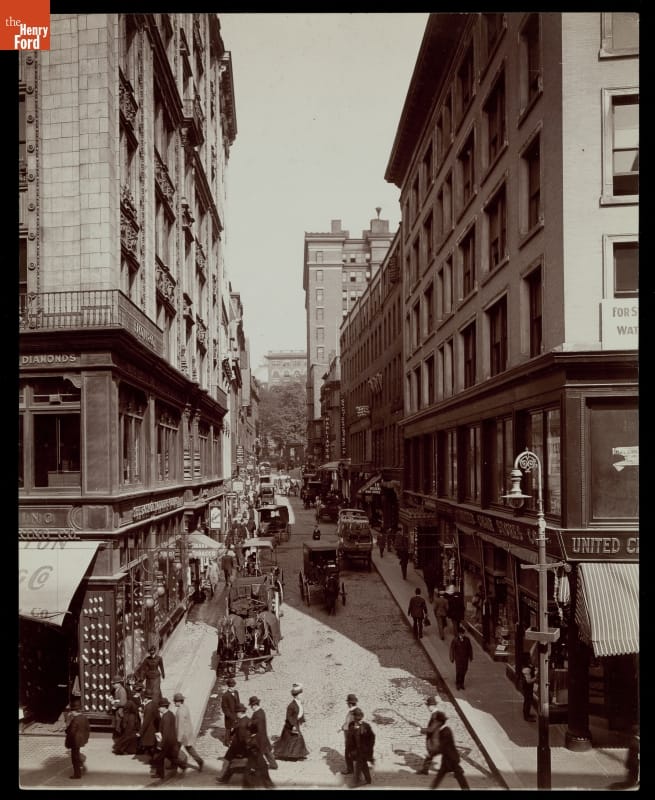
This Boston street scene, circa 1908, shows pedestrians and horse-drawn carriages on the road—but no cars. / THF203438
Most of the commercial traffic in cities still moved in horse-drawn vehicles. Rural Americans simply accepted the limited travel radius of horse- or mule-drawn vehicles. For long distances, Americans used our extensive, well-developed railroad network. People did not need automobiles to conduct their daily activities. Rather, the people who bought cars used them as a new means of recreation. They drove them on joyrides into the countryside. The recreational aspect of these early cars was so important that people of the time divided motor vehicles into two large categories: commercial vehicles, like trucks and taxicabs, and pleasure vehicles, like private automobiles. The term “passenger cars” was still years away. The automobile was an amazing invention, but it was essentially an expensive toy, a plaything for the rich. It was not yet a true innovation.
Henry Ford had a wider vision for the automobile. He summed it up in a statement that appeared in 1913 in the company magazine, Ford Times:
“I will build a motor car for the great multitude. It will be large enough for the family but small enough for the individual to run and care for. It will be constructed of the best materials, by the best men to be hired, after the simplest designs that modern engineering can devise. But it will be so low in price that no man making a good salary will be unable to own one—and enjoy with his family the blessings of hours of pleasure in God’s great open spaces.”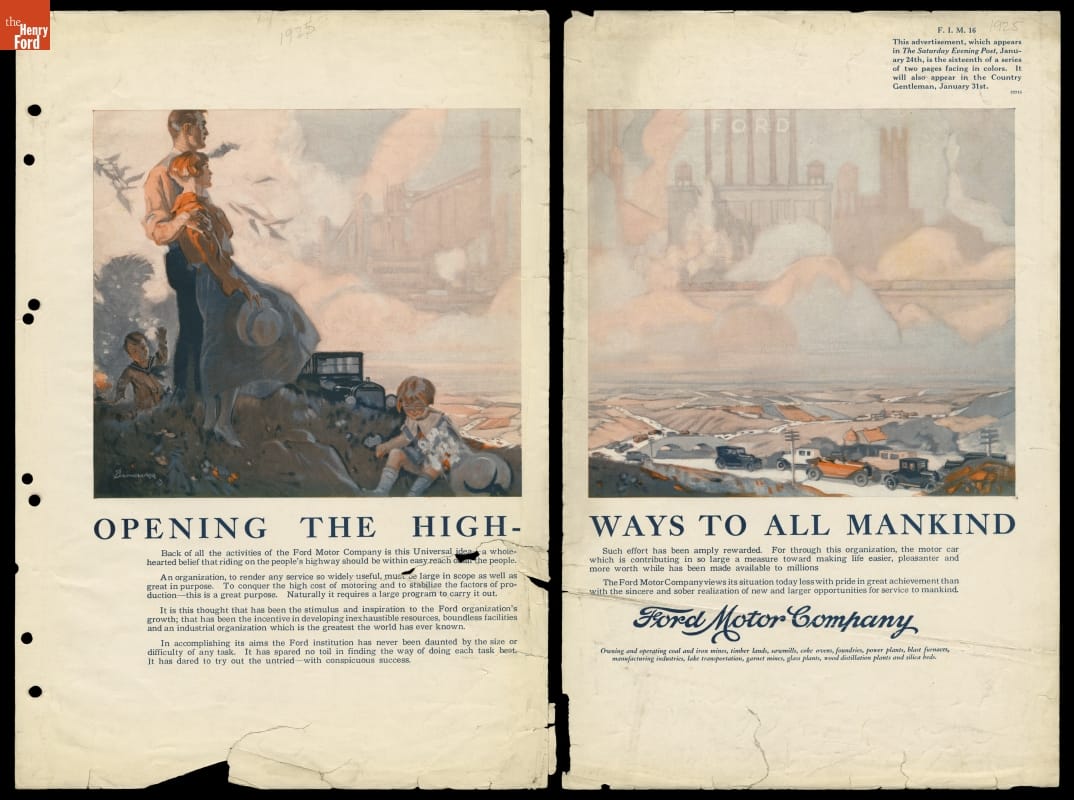
This 1924 Ford ad, part of a series, echoes the vision expressed 11 years earlier by Henry Ford: “Back of all of the activities of the Ford Motor Company is this Universal idea—a wholehearted belief that riding on the people’s highway should be in easy reach of all the people.” / THF95501
It was this vision that moved Henry Ford from inventor and businessman to innovator. To achieve his vision, Ford drew on all the qualities he had been developing since childhood: curiosity, self-confidence, mechanical ability, leadership, a preference for learning by trial and error, a willingness to take risks, and an ability to identify and attract talented people.
One Innovation Leads to Another
Ford himself guided a design team that created a car that pushed technical boundaries. The Model T’s one-piece engine block and removable cylinder head were unusual in 1908 but would eventually become standard on all cars. The Ford’s flexible suspension system was specifically designed to handle the dreadful roads that were then typical in the United States. The designers utilized vanadium alloy steel that was stronger for its weight than standard carbon steel. The Model T was lighter than its competitors, allowing its 20-horsepower engine to give it performance equal to that of more expensive cars. The Model T forever changed the automotive industry and American culture. Its impact can still be felt today.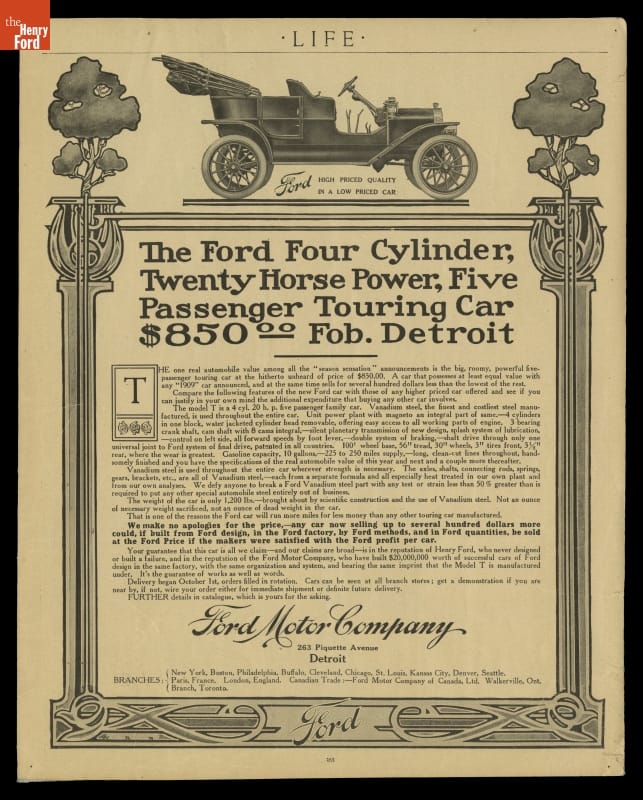
1908 advertisement for the 1909 Ford Model T. In advertisements, Ford Motor Company emphasized key technological features and the low prices of their Model Ts. Ford's usage of vanadium steel enabled the company to make a lighter, sturdier, and more reliable vehicle than other early competitors. / THF122987
The new Ford car proved to be so popular that Henry could easily sell all he could make, but he wanted to be able to make all he could sell. So Ford and his engineers began a relentless drive both to raise the rate at which Model Ts could be produced and to lower the cost of production.
In 1910, the company moved into a huge new factory in Highland Park, a city just north of Detroit. Borrowing ideas from watchmakers, clockmakers, gunmakers, sewing machine makers, and meat processors, Ford Motor Company had, by 1913, developed a moving assembly line for automobiles. But Ford did not limit himself to technical improvements.
When his workforce objected to the relentless, repetitive work that the line entailed, Ford responded with perhaps his boldest idea ever—he doubled wages to $5 per day. With that one move, he stabilized his workforce and gave it the ability to buy the very cars it made. He hired a brilliant accountant named Norval Hawkins as his sales manager. Hawkins created a sales organization and advertising campaign that fueled potential customers’ appetites for Fords. Model T sales rose steadily while the selling price dropped. By 1921, half the cars in America were Model Ts, and a new one could be had for as little as $415.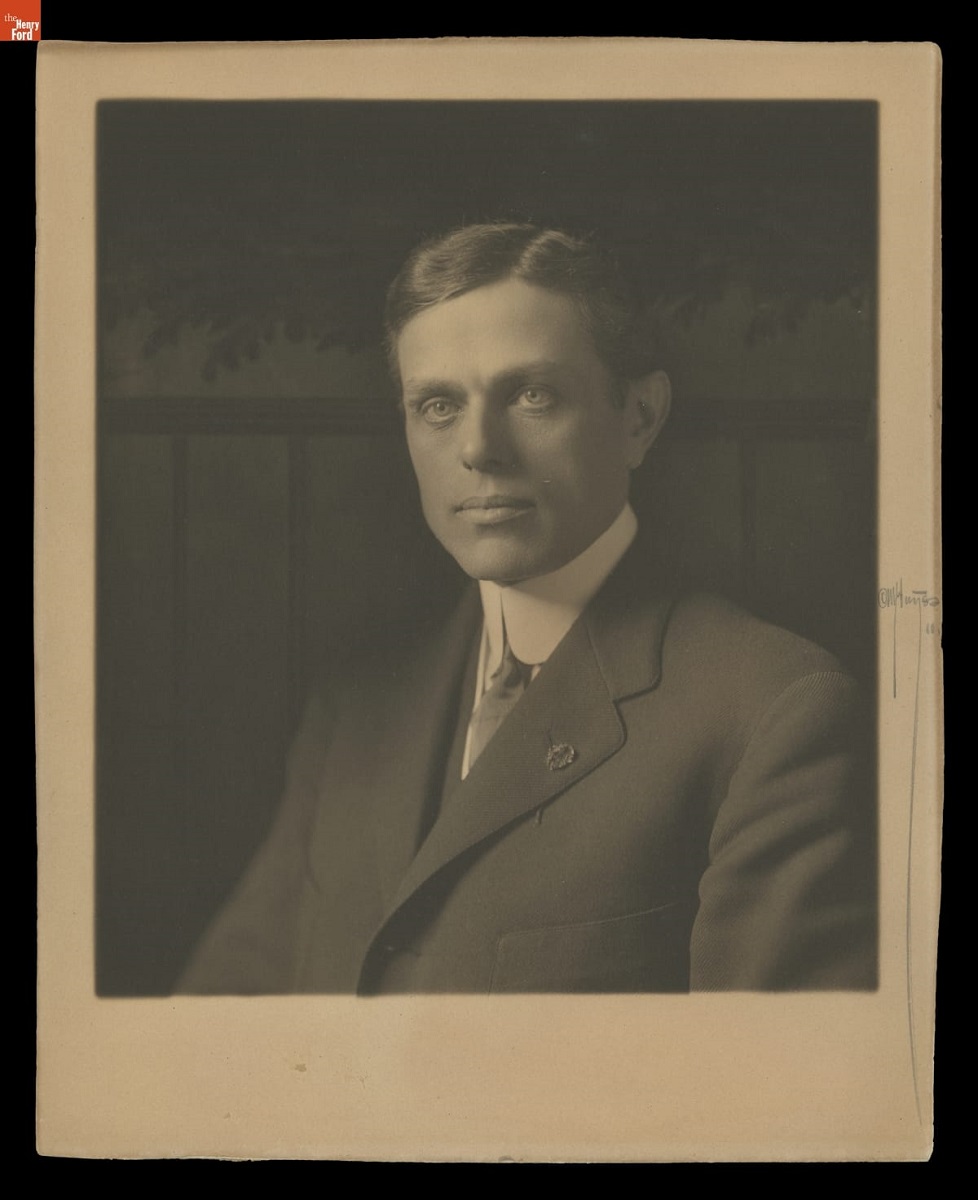
Norval Hawkins headed the sales department at Ford Motor Company for 12 years, introducing innovative advertising techniques and increasing Ford’s annual sales from 14,877 vehicles in 1907 to 946,155 in 1919. / THF145969
Through these efforts, Ford turned the automobile from an invention bought by the rich into a true innovation available to a wide audience. By the 1920s, largely as a result of the Model T’s success, the term “pleasure car” was fading away, replaced by “passenger car.” Ford’s moving assembly line and $5 day ushered in a new era of mass production and affordability. American society itself was transformed as motorists were free to travel where they wanted, when they wanted.
The assembly line techniques pioneered at Highland Park spread throughout the auto industry and into other manufacturing industries as well. The high-wage, low-skill jobs pioneered at Highland Park also spread throughout the manufacturing sector. Advertising themes pioneered by Ford Motor Company are still being used today. Ford’s curiosity, leadership, mechanical ability, willingness to take risks, ability to attract talented people, and vision produced innovations in transportation, manufacturing, labor relations, and advertising. His legacy is preserved at places like Greenfield Village, showcasing his impact on American life and the evolution of the automotive industry.
What We Have Here Is a Failure to Innovate
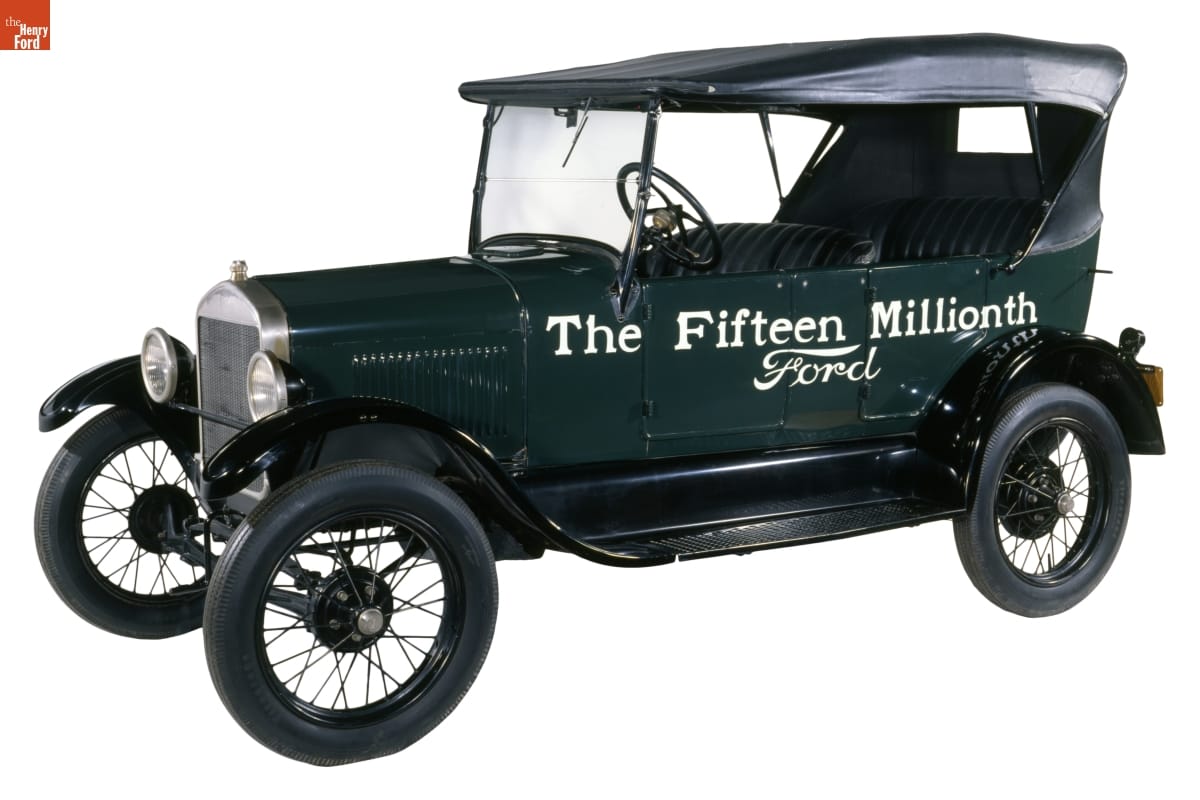
Henry Ford was slow to admit that customers no longer wanted the Model T. However, in 1927, he finally acknowledged that shift, and Henry Ford and his son, Edsel Ford, drove this last Model T—number 15,000,000—off the assembly line at Highland Park. / THF135450
Henry Ford’s great success did not necessarily bring with it great wisdom. In fact, his very success may have blinded him as he looked to the future. The Model T was so successful that he saw no need to significantly change or improve it. He did authorize many detail changes that resulted in lower cost or improved reliability, but there was never any fundamental change to the design he had laid down in 1907.
He was slow to adopt innovations that came from other carmakers, like electric starters, hydraulic brakes, windshield wipers, and more luxurious interiors. He seemed not to realize that the consumer appetites he had encouraged and fulfilled would continue to grow. He seemed not to want to acknowledge that once he started his company down the road of innovation, it would have to keep innovating or else fall behind companies that did innovate. He ignored the growing popularity of slightly more expensive but more stylish and comfortable cars, like the Chevrolet, and would not listen to Ford executives who believed it was time for a new model.
But Model T sales were beginning to slip by 1923, and by the late 1920s, even Henry Ford could no longer ignore the declining sales figures. In 1927, he reluctantly shut down the Model T assembly lines and began the design of an all-new car. It appeared in December 1927 and was such a departure from the old Ford that the company went back to the beginning of the alphabet for a name—it was called the Model A.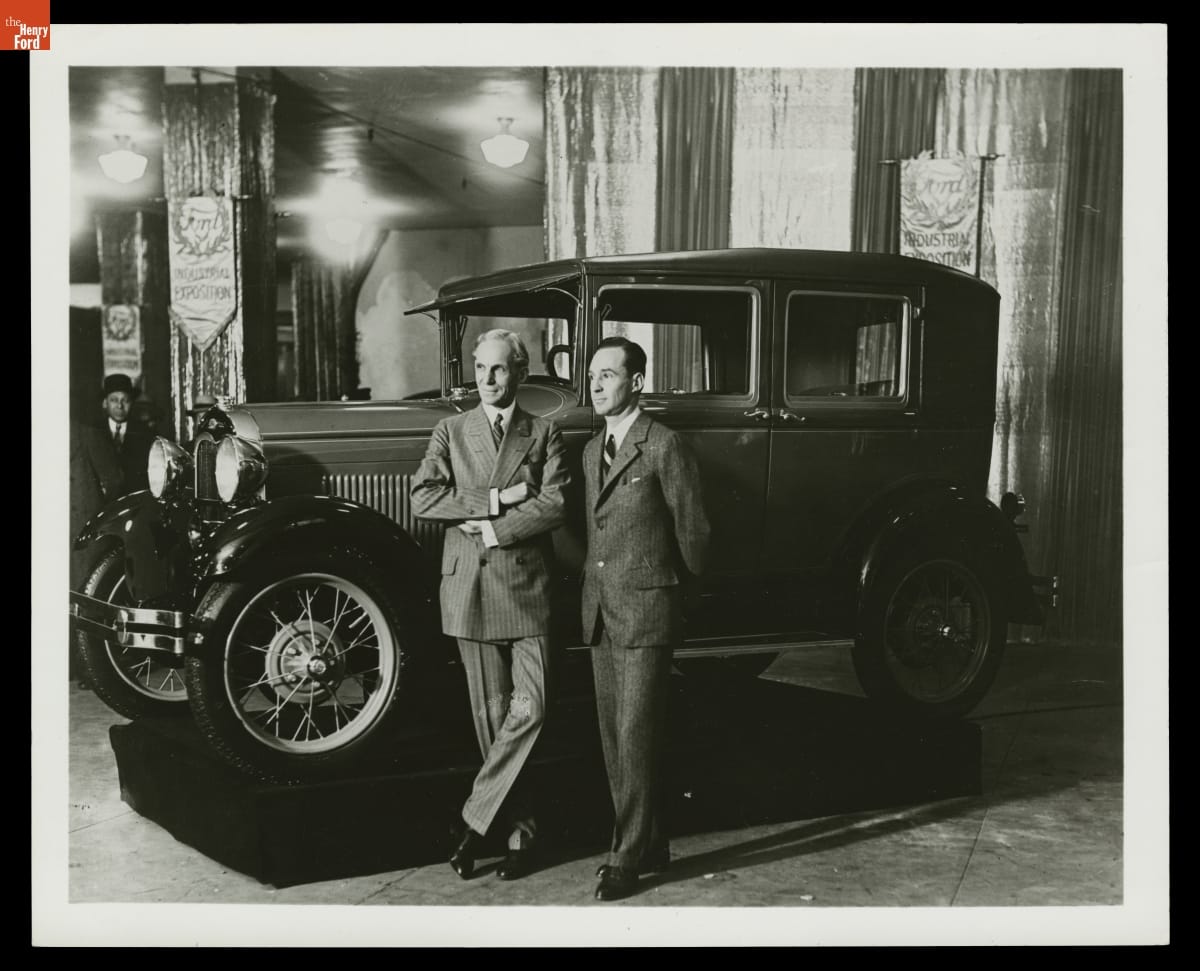
Edsel and Henry Ford introduce the new Model A at the Ford Industrial Exposition in New York in January 1928. Edsel had worked to convince his father to replace the outmoded Model T with something new. / THF91597
One area where Ford did keep innovating was in actual car production. In 1917, he began construction of a vast new plant on the banks of the Rouge River southwest of Detroit. This plant would give Ford Motor Company complete control over nearly all aspects of the production process. Raw materials from Ford mines would arrive on Ford boats, and would be converted into iron and steel, which were transformed into engines, transmissions, frames, and bodies. Glass and tires would be made onsite as well, and all of this would be assembled into completed cars. Assembly of the new Model A was transferred to the Rouge. Eventually the plant would employ 100,000 people and generate many innovations in auto manufacturing. The River Rouge complex became a symbol of Ford's ambition and scale, a testament to his vision for vertically integrated production.
But improvements in manufacturing were not enough to make up for the fact that Henry Ford was no longer a leader in automotive design. The Model A was competitive for only four years before needing to be replaced by a newer model. In 1932, at age 69, Ford introduced his last great automotive innovation, the lightweight, inexpensive V-8 engine. It represented a real technological and marketing breakthrough, but in other areas Fords continued to lag behind their competitors. The Ford factory continued to evolve, but the company faced new challenges in keeping up with changing consumer preferences and technological advancements in the automotive industry.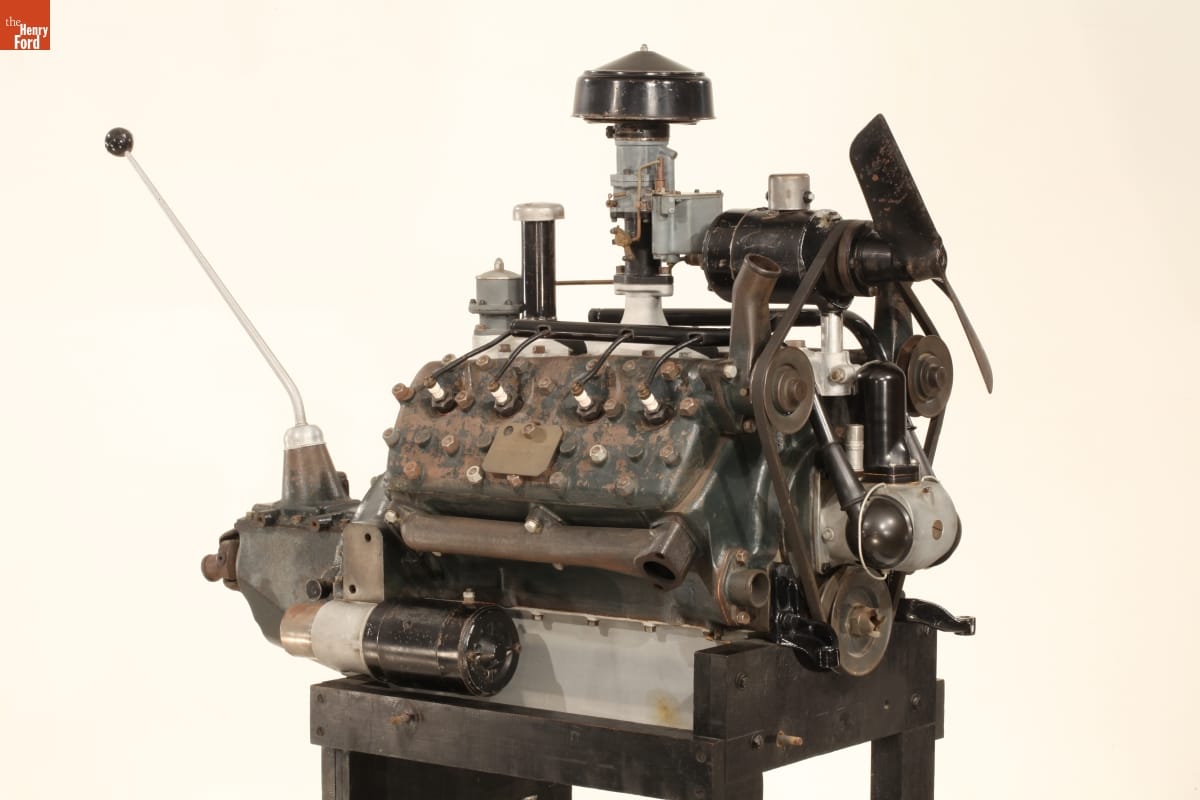
The V-8 engine was Henry Ford’s last great automotive innovation. This is the first V-8 engine produced, which is on exhibit in Henry Ford Museum of American Innovation. / THF101039
By 1936, the company that once sold half of the cars made in America had fallen to third place behind both General Motors and the upstart Chrysler Corporation. By the time Henry Ford died in 1947, his great company was in serious trouble, and a new generation of innovators, led by his grandson Henry Ford II, would work long and hard to restore it to its former glory. Henry’s story is a textbook example of the power of innovation—and the power of its absence. His contributions to the automotive industry and American society are undeniable, but his later resistance to change serves as a cautionary tale.
Bob Casey is former Curator of Transportation at The Henry Ford. This post is adapted from an educational document from The Henry Ford titled “Henry Ford and Innovation: From the Curators.”
Detroit, Michigan, Dearborn, 20th century, 19th century, quadricycle, Model Ts, manufacturing, Henry Ford, Ford Rouge Factory Complex, Ford Motor Company, entrepreneurship, engines, engineering, cars, by Bob Casey, advertising
Motor Muster Returns for 2021

We spotlighted racing at Motor Muster for 2021. This 1953 Oldsmobile 88 stock car, brought to us by the R.E. Olds Transportation Museum, fit the theme perfectly. / Image from The Henry Ford’s livestream
Gearheads and automobile aficionados had reason to celebrate as Motor Muster returned to Greenfield Village on June 19 and 20. Like so much else, last year’s show was canceled in the wake of COVID-19. But with restrictions eased and a brighter situation all around, we returned in 2021 for another memorable show. We also welcomed a new sponsor. For the first time, this year’s Motor Muster was powered by Hagerty.
It’s no surprise, given the recent opening of our exhibit Driven to Win: Racing in America Presented by General Motors, that our Motor Muster spotlight was on racing. Yes, we had competition cars in the mix, but we opened the celebration to include production cars inspired by racing events, locations, and personalities. Whether it’s a model like Bonneville or a make like Chevrolet, racing names have appeared on automobiles from the start.
The Henry Ford’s 1953 Ford Sunliner convertible, official pace car at that year’s Indianapolis 500. / Image by Matt Anderson
As always, we brought out a special vehicle from The Henry Ford’s collection. Many of our prominent competition cars are in Driven to Win, but we found a perfect match for the theme in our 1953 Ford Sunliner. The convertible served as pace car at the 1953 Indianapolis 500, driven by William Clay Ford in honor of Ford Motor Company’s 50th anniversary. In addition to its decorative lettering (with flecks of real gold in the paint), the pace car featured a gold-toned interior, distinctive wire wheels, and a specially tuned V-8 engine rated at 125 horsepower.
From the GM Heritage Center, a 1955 Chevrolet from the days when stock cars were still largely stock. / Image by Matt Anderson
Our friends at General Motors got into the spirit of things by lending an appropriate car from the GM Heritage Center collection. Their 1955 Chevrolet 150 sedan is a replica of the car in which NASCAR driver Herb Thomas won the 1955 Southern 500 at Darlington Raceway. Thomas’s car benefited from Chevy’s new-for-’55 V-8 engine which, with the optional PowerPak dual exhausts, was rated at 180 horsepower. The Chevy small-block design went on to win more NASCAR races than any other engine.
Historical vignettes were in place throughout Greenfield Village—everything from a Civilian Conservation Corps setup from the 1930s to a patriotic bicentennial picnic right out of the mid-1970s. Even the Herschell-Spillman Carousel got into the spirit of the ’70s, playing band organ arrangements of the hits of ABBA. (I wonder if that 1961 Volvo at the show ever drove past the carousel. What a smorgasbord of Swedish splendor that would’ve been!)
Our awards ceremony included prizes for unrestored cars, like this 1941 Ford Super Deluxe Fordor. / Image by Matt Anderson
As always, we capped the weekend with our awards ceremony. Our popular choice voting allows visitors to choose their favorite vehicles from each Motor Muster decade. Top prize winners this year included a 1936 Hupmobile, a 1948 MG TC, a 1958 Chevrolet Corvette, a 1969 Plymouth Barracuda, and a 1976 Ford Econoline van. The blue ribbon for motorcycles went to a 1958 Vespa Allstate, and the one for bicycles to a 1952 JC Higgins bike. For commercial and military vehicles, our top vote-getters were a 1937 Ford 77 pickup and a 1942 White M2A1 half-track, respectively. We also presented trophies to two unrestored vehicles honored with our Curator’s Choice award. For 2021, those prizes went to a 1936 Buick Victoria Coupe and a 1967 Chevrolet C/10 pickup.
It was a longer-than-usual time in coming, but Motor Muster 2021 was worth the wait. Everyone was in good spirits and enjoying the cars, the camaraderie, and the chance to enjoy a bit of normalcy after a trying year. Let’s all do it again soon.
If you weren’t able to join us at Motor Muster this year, though, you can watch parts of the program right now. Our popular pass-in-review program, in which automotive historians provide commentary on participating vehicles, returned this year with a twist. We livestreamed portions of the program so that people who couldn’t attend Motor Muster in person could still enjoy some of the show. Enjoy those streams below, or use the links in the captions to jump straight to Facebook.
Michigan, Dearborn, 21st century, 2020s, racing, race cars, Motor Muster, Greenfield Village, events, cars, by Matt Anderson
 Server shows off an array of pastries at Eagle Tavern, 2007. Photograph by Michelle Andonian. / THF54295
Server shows off an array of pastries at Eagle Tavern, 2007. Photograph by Michelle Andonian. / THF54295
April 1, 1982, was a momentous day in Greenfield Village! That was the day that Eagle Tavern opened to the public. It was our first historic dining experience—the result of months of research, recipe selection and testing, and interpretive planning. How did all this come about?
Historical presenters and food service staff pose in front of Eagle Tavern to celebrate the new dining experience, 1982. / THF237355
The Food Committee
It started when we took a chance on a young museum leader named Harold Skramstad, who became our president in 1981. Faced with a severe financial crisis at the time, Skramstad built a case around our “world-class” status and “unique historical resources.” This led to the creation of our first mission statement, which focused upon the process of change in America from a rural agricultural society to an urban industrial nation. Following that, Skramstad created several task forces and committees, each charged with developing plans to carry out our mission through a variety of public programs. This included the mysteriously named Food Committee. It turned out that this committee—comprised of curators, food service staff, and interpretation specialists—was charged with exploring ways to bring our food offerings in line with our overall interpretive framework.
Food vendor in Greenfield Village. / THF133689
Soon, new food experiences began to appear. Through the Food Committee’s collaborative efforts, vendors hawked fruit and penny candy from rolling carts like those that had been seen on urban street corners a century ago. At the Covered Bridge Lunch Stand (now Mrs. Fisher’s), visitors could partake of turn-of-the-century picnic lunches. With the help of diner expert Richard Gutman—who informed us that we possessed the last remaining lunch wagon in existence—the Owl Night Lunch Wagon was overhauled to look more like a late-19th-century lunch wagon, featuring a more historic menu. But Eagle Tavern became our “crown jewel,” as we proposed turning this historic inn into a sit-down full-service restaurant with period food and drink.
What had the building been like before this?
Clinton Inn

Ella Smith, the final owner, in front of the inn on its original site in Clinton, Michigan, circa 1905. / THF110475
In 1927—searching for a stagecoach tavern for his Village Green—Henry Ford found and purchased this imposing 1830s-era inn. From Clinton, Michigan, it was situated along what once had been the main stagecoach road between Detroit and Chicago. Over the years, the inn had gone through several proprietors and name changes, from Parks Tavern to Eagle Tavern to the Union Hotel to Smith’s Hotel. When Henry Ford had the building reconstructed in Greenfield Village, he gave it the generic name Clinton Inn.
Carriages waiting for passengers at Clinton Inn. / THF120768
From 1929 into the 1950s, the building served as a cafeteria for students attending the Edison Institute schools. Ford enlarged the back of the structure for that purpose. When Greenfield Village officially opened to the public in 1933, Clinton Inn became the starting point for public carriage tours.
1950 calendar for Greenfield Village, featuring Clinton Inn. / THF8882
In the 1950s, the building transitioned from a student lunchroom to a public cafeteria. That was still its use when I first started working at The Henry Ford (then called Henry Ford Museum & Greenfield Village) in 1977. Also when I started, Clinton Inn’s so-called “colonial kitchen” was used for fireplace cooking classes as part of the institution’s Adult Education Program.
Why Eagle Tavern?
Why did we choose the Eagle Tavern era to interpret? To establish a date for the historic dining experience, we looked to primary sources, as we do when we research all of our historic structures. These sources, which help us uncover the esoteric details of the past, included probate records, property deeds, tax and census records, and local newspapers. Through this research, we found that a farmer named Calvin Wood ran this tavern from 1849 to 1854, with his wife Harriet, Harriet’s daughter Irene, and additional hired help from town or the neighboring countryside. In keeping with the patriotic spirit of the time, Wood named the place Eagle Tavern.
We decided that we liked this early 1850s date. Not only did we have decent documentation on Calvin Wood, but it was also an interesting era for changes in cooking ingredients and cookbooks (both more available than before) as well as public dining practices and customs (toward more choices for individual diners, better table etiquette, more formalized meals and menus, and more specialized table settings).
The 1850s date also dovetailed with our new mission statement—about change over time—in larger ways that were transforming the entire nation at the time. These included social movements like temperance, abolition, and women’s rights; advancements in transportation, from horse-drawn vehicles to speedy railroads; and improved communication networks, as the telegraph swiftly brought the latest news to the public. Significant national events like the California Gold Rush and the Mexican War were also impacting many people’s lives.
A variety of horse-drawn vehicles passing in front of a Middletown, Connecticut, tavern, 1842–47. / THF204148
Michigan Central Railroad car, 1848. / THF147798
Researching the Food
My primary task in creating the Eagle Tavern dining experience was to find out what and how people ate during this era. I delved deeply into period sources looking for clues to these questions, including travelers’ accounts, etiquette books, merchants’ account books, newspaper ads, and historical reminiscences.
Within these sources, I found several quite eye-opening entries, like that of Isabella Bird, a British traveler who described this meal placed in front of her at a Chicago hotel in 1856: “…eight boiled legs of mutton, nearly raw; six antiquated fowls, whose legs were of the consistency of guitar-strings; baked pork with “onion fixings,” the meat swimming in grease; and for vegetables, yams, corn-cobs, and squash. A cup of stewed tea, sweetened by molasses, was at each plate…The second course consisted exclusively of pumpkin-pies.”
It’s probably good that we didn’t take these accounts completely literally when we developed the Eagle Tavern dining experience!
From these research sources, I learned that tavern fare would have come from a combination of local farms (especially, in this case, Calvin Wood’s own farm), from the fields and woods of the surrounding area, and using ingredients that would have been purchased from local merchants.
A cold plate featuring chicken salad, pictured in the 1988 Eagle Tavern Cookbook. / THF121002
The primary components of a tavern meal would have consisted of meat, vegetables and fruits (in various forms), and breadstuffs. Meat was the predominant component of the tavern meal, served in much greater quantity than today. Often, two or more meats were served at one meal. Pork, the staple food of many midwestern settlers, was the most popular meat, served in a variety of forms—including roasted, salted, baked, and as bacon, smoked ham, sausage, or spareribs. Chickens, easy to raise on farms, lent themselves to many dishes. They also could supply eggs. In fact, Lansing Swan, traveling through Sturgis, Michigan, in 1841, wrote: “We had an excellent dinner, warm cakes, tea, etc. bacon and eggs. I have eaten them until I am ashamed to see a hen and can hardly look a respectable porker in the face.”
Beef contributed to a portion of the tavern meals, as did wild game and fish from local lakes and rivers. Oysters were also popular at the time, packed on ice and transported in barrels from the East coast.
An array of vegetables for Eagle Tavern dishes, pictured in the 1988 Eagle Tavern Cookbook. / THF121001
As for vegetables, root crops lasted throughout the year and they stored easily. Potatoes were especially popular, as described in this southern Michigan meal by Charles Hoffman in 1833: “…hot rolls, tea, large pieces of pork swimming in its gravy, and a plate of potatoes that pulverized when you touched them.” Cabbage, onions, turnips, and carrots were other root crops frequently found in the research. Less hardy vegetables, like tomatoes and cucumbers, were served in season or preserved as catsups, sauces, or pickles. Pumpkins, squash, and corn were usually served in season or preserved for later use.
Fruits were served fresh in season, dried, or made into preserves, sauces, or pickles. Of these, apples were most frequently used as they were incredibly versatile—preserved, cooked, or baked into numerous dishes. Peaches, pears, apricots, grapes, and berries of all sorts were also found in the accounts. Wild strawberries were specifically called out several times by traveler Lansing Swan, in 1841. In Ypsilanti, Swan “got an excellent supper for 25 cents and many large delicious strawberries with rich cream.” Farther west, in Jackson, he happily remarked that he was, “Just in time for tea with strawberries and cream.” In Niles, he and his companion “came in time for another strawberry repast and a rich one it was. We had a new dish, ‘Strawberry Short Cake,’ very fine indeed.” And before leaving Niles the next morning, he partook of one last “strawberry breakfast.” Raisins, dried figs, prunes, currants, and citron were listed in grocery store ads and could be purchased.
A variety of muffins and rolls served at Eagle Tavern, 2007. Photograph by Michelle Andonian. / THF54331
Breadstuffs contributed substantially to tavern meals, mentioned often in travel accounts as a meal accompaniment—but not always with approval! For example, Cyrus Bradley, dining in a tavern between Detroit and Pontiac in 1835, remarked: “The milk was sweet, but the bread was dry and stale and as it began to saturate, the little red bugs rose, kicking most lustily, to the surface, where they were immediately skimmed off and most barbarously committed to the flames.”
Wheat flour and cornmeal were processed at local mills and could be used for baking breads, rolls, biscuits. Charles Hoffman, in 1833, remarked that Michigan had the “best wheat bread in the world.”
Creating the Menus
From all of these accounts, I created a master list of dishes and ingredients. Then I perused every historic cookbook I could find. Fortunately, the number of printed cookbooks was on the rise by the mid-19th century, although measurements, cooking times, and temperatures were not precise—which is why so much recipe testing had to be done. Within the pages of these cookbooks, I searched for recipes that were specifically referenced in historic accounts, those that seemed regional, and those that included ingredients on my researched ingredients list.
The Good Housekeeper, from 1841, was one of several cookbooks perused for possible recipes. / THF120853
I organized my collected recipes by type—for instance, entrees, pastries, soups, vegetables—and then spent innumerable hours with the food service managers at Eagle Tavern debating and selecting the final recipes. The managers brought up constraints that I would never have considered as a curator—including modern cost and availability of ingredients as well as the durability of certain dishes on the steam table that was still being used from the old cafeteria setup. Probably our most animated conversations related to how adventurous we thought modern visitors would be in trying things that were different and unusual—like mock turtle soup and beef tongue! Once determined, the agreed-upon recipes were tested by food service cooks (this predated having chefs on staff) who, after weeks of testing, invited us to a grand two-day food tasting.
Elaborate Bill of Fare for Thanksgiving Day, 1847, at the Adams House in Boston, Massachusetts. / THF147797
At the same time, I searched for examples of historic menus from the era to see what constituted a tavern meal. As it turned out, most tavern meals started with soup and ended with a dessert course of dried fruit and nuts. (The phrase “from soup to nuts” must have originated at this time!) The Eagle Tavern menu, or “Bill of Fare,” was laid out much like the historic menus of the time but included a simpler selection of dishes that were regionally and seasonally appropriate. Today, the Eagle Tavern Bills of Fare still follow these guidelines.
Eagle Tavern’s first Bill of Fare, Spring 1982. / THF123845
The Dining Experience
According to travel narratives of the era, tavern dining was fast and furious. For example, one traveler in Chicago in 1836 wrote: “…every man for himself, and none for his neighbor; hurrying, snatching, gulping, like famished wildcats; victuals disappearing as if by magic.” Partly, this was because there were often more patrons than space at the one “common table” in an inn. To resolve this, diners often took turns eating, as James Logan described in a hotel in Detroit in 1838: “Very little conversation took place, each individual seemed to hurry on as fast as possible, and the moment one finished he rose and went away. There was not change of plates, knives, or forks, every thing being eaten off the same plate, excepting pudding, which was taken in saucers.”
For the Eagle Tavern dining experience, we knew we were not about to recreate James Logan’s experience! But how, we wondered, could we simulate the concept of the “common table” for modern visitors? Fortunately, because of the spacious cafeteria area that Henry Ford had added to the building back in the 1920s, we found that we could furnish the space with not one but several tables that simulated communal dining. It also gave us the option of seating people at separate tables if additional privacy were desired.

The Eagle Tavern table setting was also the result of historical research, found in Catherine Beecher’s 1850 Domestic Receipt Book. / THF147807
Today’s dining experience at Eagle Tavern is much like it was back when we first created this experience almost 40 years ago. To me, Eagle Tavern was—and still is—one of the best historic dining experiences around!
Donna R. Braden is Senior Curator and Curator of Public Life at The Henry Ford.
Additional Readings:
- Eagle Tavern at its Original Site, Clinton, Michigan, February 2, 1925
- Behind the Bar at Eagle Tavern
- Eagle Tavern Inspiration to Enjoy at Home
- Menu from Clinton Inn (now Eagle Tavern), Greenfield Village, 1952
19th century, 1850s, Dearborn, 20th century, 1980s, restaurants, research, Michigan, Greenfield Village history, Greenfield Village buildings, Greenfield Village, food, Eagle Tavern, by Donna R. Braden, #Behind The Scenes @ The Henry Ford
Membership Spotlight: Mary Aviles

Mary Aviles and son Mati in Thomas Edison’s Menlo Park Complex.
Ten-plus-year member Mary Aviles finds inspiration in a frog, two brothers, and makers in the raw.
Drawn to the Herschell-Spillman Carousel in Greenfield Village, Mary loves hopping on the whimsical bow-tie-wearing frog. The carousel reminds her of stories shared with her children to spark their curiosity and quest for lifelong learning. She’s equally inspired each time she walks into Orville and Wilbur Wright’s family home in Greenfield Village, knowing that human progress is cumulative and many of our major leaps forward can be traced to specific moments in time. A repeat attendee at The Henry Ford’s annual Maker Faire® Detroit, she can’t wait to come back each year, because she sees great beauty in unfinished ideas and the limitless potential of creativity in the rough.
Her must-do:
Maker Faire® Detroit
Her favorite member perk:
“The Henry Ford Magazine. I use it regularly until it’s dog-eared.
I worked for TechTown Detroit with entrepreneurs/ small businesses and continue to do so as a consultant with EarlyWorks. For me, The Henry Ford’s Model i framework is also an inspiration. TechTown architects use it as an approach to client relationship management, and I reference the framework consulting with EarlyWorks.
As a qualitative researcher specializing in structuring unstructured data, I am fascinated by how The Henry Ford has synthesized its collection of physical innovator assets to remain relevant in informing issues such as education, workforce and talent development—topics I, along with my clients, are immersed in every day.”
What’s your spark? Let us know what inspires you on your next visit and what takes you forward from your membership. Email us at membership@thehenryford.org. Take it forward as a member—enjoy benefits like free parking, discounts on events and tours, exclusive member previews, and more.
This post was adapted from an article in the June-December 2019 issue of The Henry Ford Magazine.
Dearborn, 21st century, 2010s, The Henry Ford Magazine, Michigan, innovation learning, Detroit

Alice McAlexander & Warren Flood, plus Malcolm. Photo courtesy Warren Flood.
One-year members Alice McAlexander, Warren Flood, and their son find wonder in a bus, a collection of trains, and a carousel.
A perennial first stop at The Henry Ford for Alice McAlexander, Warren Flood, and their son, Malcolm, is the Rosa Parks Bus in the museum’s With Liberty and Justice for All exhibition, where powerful storytelling offers an affecting, unforgettable journey from then to now without fail. After moving to Michigan during the frigid winter, this trio found The Henry Ford a twice-weekly indoor wonderland, smoothing their transition from sunny Los Angeles. Euphoria for Malcolm is when he is perched on the museum’s New Holland combine or the village’s Herschell-Spillman Carousel. For the couple, The Henry Ford delivers hope and optimism for their son and all the next generations, linking historical creativity and invention with future innovation.
Their must-dos:
Seeing the different trains, carriages, and Model T’s throughout the museum and then watching them spring to life in a whole new way in Greenfield Village. Letting their son feed his obsession for the Mold-A-Ramas in the museum. He has collected nearly every mold.
Their favorite member perk:
“Our two-year-old wakes up and asks to go to the museum or Greenfield Village all the time, and every trip is a guaranteed great adventure full of new sights and experiences.”
What’s your spark? Let us know what inspires you on your next visit and what takes you forward from your membership. Email us at membership@thehenryford.org. Take it forward as a member—enjoy benefits like free parking, discounts on events and tours, exclusive member previews, and more.
This post was adapted from an article in the June-December 2020 issue of The Henry Ford Magazine.
2020s, Greenfield Village, Henry Ford Museum, Michigan, Dearborn, 21st century, The Henry Ford Magazine
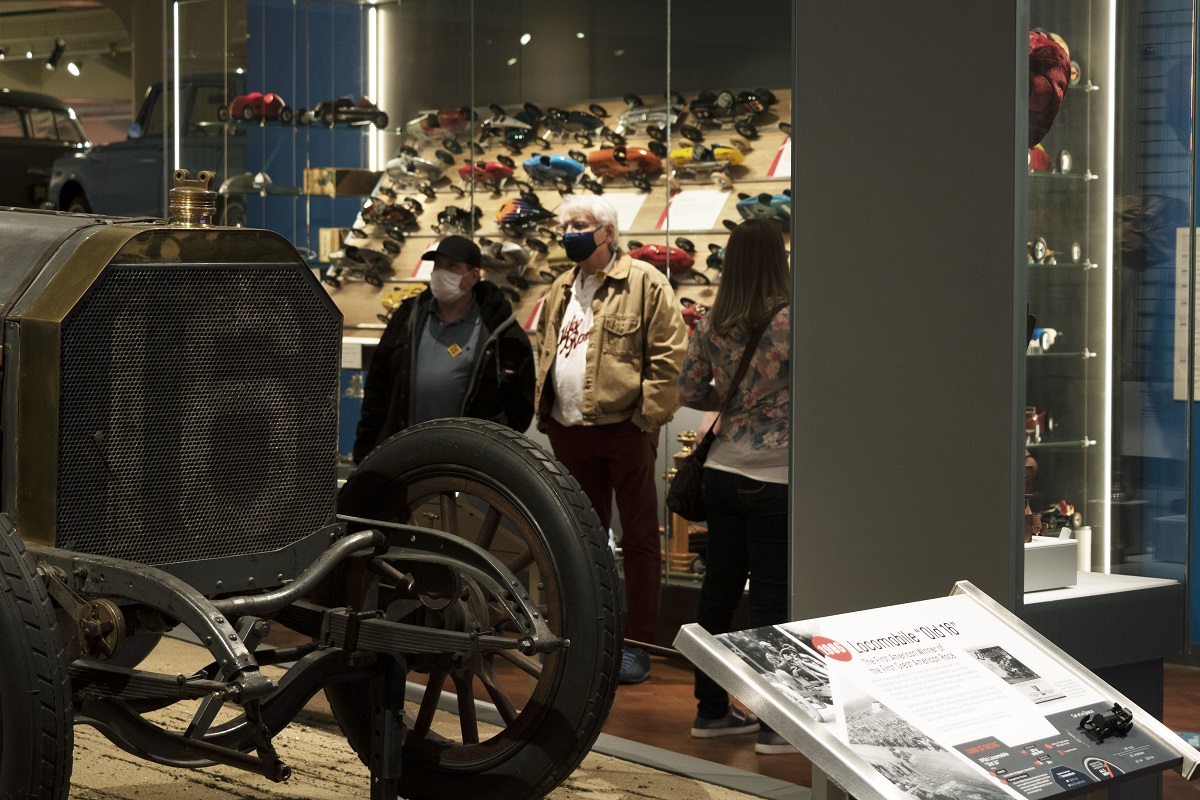
Since the opening on March 27, 2021, of The Henry Ford's newest permanent exhibition, Driven to Win: Racing in America presented by General Motors, hundreds of guests have experienced the enthusiasm and excitement it creates in all who walk through its 24,000 square feet. Patricia Mooradian, president and CEO of The Henry Ford, explains that "motorsports and the Driven to Win exhibit fit precisely within the vision of The Henry Ford because the spirit of racing is indelibly intertwined with a singular focus on innovation and is rife with concrete examples of that can-do spirit, that attitude that's at the heart of America."
Driven to Win has been in the works for more than a decade. Many creative and innovative minds came together to make it a reality. When the idea of a permanent racing exhibit arose, it presented an opportunity to take the idea to those on a national platform. The Henry Ford sought advice and assistance from leaders in the world of motorsports, including Edsel B. Ford II, Jack Roush, and Roger Penske.
For Spence Medford, vice president and chief advancement officer at The Henry Ford, "It was more than just raising money for an exhibit; it was the opportunity to take the good word and message of The Henry Ford on the road. We were able to take our mission all over to different races and race tracks and introduce it to those who otherwise would never have heard of our mission had we not put this exhibit into motion." The national platform gave The Henry Ford a chance to also share our mission internationally and reach racing enthusiasts all over the world.

Driven to Win highlights the stories, artifacts, and people who were the driving forces and true champions of racing. By telling these stories, we hope to inspire the next generation of racers, engineers, entrepreneurs, innovators, and racing fans. Everyone who comes to see the exhibition will be able to unlock their own potential in the stories of failures, successes, and the spirit of never giving up, told through the lives of the people who are highlighted.
Jim Campbell, U.S. vice president of performance and motorsports for General Motors, agrees: "Driven to Win: Racing in America is inspiring because it tells the story of the people that were integral to the sport. The exhibit tells the story through actual race cars, artifacts, engines, and transmissions. We need to inspire more people to discover opportunities within racing, and this exhibit will do just that."
Lyn St. James, racing legend and official adviser to the exhibition, was excited to learn that we would be showcasing the vast history of all automotive racing groups within the United States. "I was so taken with the fact that this would be an opportunity to not just tell the history of Ford racing but the history of racing in America and how competition and innovation impact society. This exhibit will bring it to life in a quality way. It is an influencer of how people are going to perceive our sport."
Beth Paretta, CEO and team principal of Paretta Autosport, concurs: "I think taking time to go through a place like The Henry Ford that is rich in content allows you to take a pause. It gives you that moment to look at the past and hopefully see it in the context of when those events happened. We can learn lessons from winning and losing and what that turns into. The Henry Ford is such a great place to get ideas and spark imagination."
Everyone who comes to see Driven to Win will find something that inspires them. After walking through the exhibition, Mark Rushbrook, global director of Ford Performance Motorsports, said, "I think that a lot of people who go through this display, even if they are not hard-core motorsports fans, a lot of the history is going to resonate with them. The things they didn't completely understand about the history of racing before will make sense when it is right in front of them. They will be able to connect to it, and that's not going to change."
The Henry Ford would like to extend our sincere gratitude and thanks to all those who helped make this exhibition a dream come true. To our sponsors—General Motors, Rolex, Brembo, and Multimatic—none of this would have been possible without your collaboration and efforts. We are very grateful for your partnerships. To all of our supporters and friends that have we gained along the way, you have truly helped to bring Driven to Win: Racing in America to life. Thank you for helping to fuel our passion and that of all those who will experience racing in America for generations to come.
Caroline Heise is Annual Fund Specialist at The Henry Ford.
Michigan, Dearborn, 21st century, 2020s, The Henry Ford Effect, racing, philanthropy, Henry Ford Museum, Driven to Win, by Caroline Heise

This photograph was taken some time between 1905 and 1911. Why? The sign in the front window of the storefront adjacent to the Wright Cycle Shop shows an undertaker’s business run by L.G. Keller. City of Dayton business directories of this period show Mr. Keller in business at 1127 West Third Street during this span of time. Clearly shown is the C .Webbert Block sign on top of the building and the Wright Cycle sign as well. Bicycle production and sales had ceased by 1905, but until 1909, airplanes and airplane engines were being built and partially assembled here. / THF236870
In 1903, the building that houses the Wright Cycle Shop and the undertakers’ establishment of Fetters & Shank was collectively known as the C. Webbert Block. The building was moved to and restored in Greenfield Village in 1937. It’s a very faithful representation of the two-story, two-storefront building that stood at 1125-1127 West Third Street in Dayton, Ohio, restored to appear as it did at the time of the Wright Brothers' first flight. There was one exception, though—the decoratively lettered sign that graced the top of the bracketed cornice spanning the front façade of the building was missing for over 100 years.
Charles Webbert, a relative by marriage to Charles Taylor, the Wright Brothers' mechanic, purchased the building in 1896. Mr. Webbert did an extensive addition to the front that created the double storefront we see in historic photographs. The Wright Brothers were his first tenants. Mr. Webbert was a plumbing supplier, a bicycle enthusiast, and, later, a great supporter of the brothers’ flying efforts. He was friends with Orville and Wilbur, and purchased and bartered both bicycles and bicycle repairs. Rent payments were dependent on what bicycle services were provided.
Between 1897 and 1916, the building saw a variety of uses by the Wright Brothers. Initially, the focus was on bicycles, including two lines of hand-built enameled finished bicycles, the Saint Clair and the Van Cleve. In the late 1890s, bicycles were a lucrative business and the proceeds from the Wrights' successful business became the funding source for everything that would eventually allow the Wright Brothers to fly.
Man Working at a Lathe in the Wright Cycle Shop, Dayton, Ohio, 1897 / THF236804
From 1899 until 1909, the building served as the brothers' first experimental laboratory and design studio, dedicated to creating that first flying machine. The first gliders, as well as the first Wright Flyer, were built in sections in the back machine shop, along with the gasoline engines that powered the first flight. For a time, the Wright Cycle Shop was one of the world’s first airplane factories. Following the sale of their first airplane to the U.S. Army Signal Corps in 1908, Orville and Wilbur attracted the attention of New York investors and the Wright Company was formed in 1909. The airplane business quickly outgrew the space, and the assembly of airplanes consequently took place in a rented space in the Speedwell Motor Car Company while awaiting completion of a new factory building. The Wrights broke ground on this new facility on Home Road in Dayton in 1910.
After 1909, though manufacturing and final assembly moved elsewhere, the gasoline-powered engines continued to be machined and assembled in the Wright Cycle Shop. Both brothers also kept offices on the second floor, along with their company files and archives.
Following Wilbur’s death from typhoid fever in May of 1912, Orville took over as president of the company and ran the business alone. In 1915, he sold his interests and retired from the Wright Company. He continued to work on aviation design with his own firm but gave up the lease at the Cycle Shop in November of 1916, permanently moving to 15 North Broadway, a few blocks away.
Based on photographic evidence, the C. Webbert sign remained in place from 1897 until 1919, when significant structural changes took place. These included the addition of another bay and a third storefront, later to become 1123 West Third Street. Historic images show the building in its final iteration, as Henry Ford would have first seen it. By the time of the 1919 renovations, the building needed significant repairs, in part due to a huge flood that ravaged downtown Dayton and its neighborhoods in the spring of 1913. Water levels reached nearly to the second floor of the building. By this time, it’s very likely that the sign had deteriorated to the point where it was not practical to redesign it to fit with the new façade, and so it was likely removed.
This photograph of the vacant building taken in October of 1936 is part of a series taken after Henry Ford purchased the building from Charles Webber, in preparation for dismantling the building and shipping it to Dearborn, Michigan. Its reconstruction in Greenfield Village, without the C. Webbert sign, was completed in the Spring of 1938 with the dedication taking place on April 16, which would have been Wilbur Wright’s 71st birthday. / THF236872
Henry Ford purchased the building from Charles Webbert in 1936 with the understanding that it would be dismantled and moved to Dearborn, where it would be reconstructed in Greenfield Village. For reasons unknown, the sign was never added to the Wright Cycle Shop when it was restored in Greenfield Village in 1937. This is surprising, as it is such a significant architectural element. In 1991, another major restoration of the building took place in the Village, and again, the sign was not included in the project.
As they say, the third time’s the charm.
In 2018, research work began, focused on recreating the sign to more accurately represent the building’s appearance in 1903. In 2019, Mose Nowland, one of our talented conservation department volunteers, created detailed construction drawings based on high resolution scans of original photographs showing the sign still in place. Mose had only a few photographs, taken several years apart, to work with. True to form with his decades of experience, his finished drawings were works of art themselves, and brought to life the exquisite details included in what was the finial crest for the newly-designed façade of the building.
Mose Nowland poses with one of his detailed architectural drawings, which allowed the C. Webbert sign to come to life again after being missing for 100 years. / Photo by Jim Johnson
Using these wonderful drawings, combined with Mose’s sound advice and suggestions, Mike Zemney, one of our talented carpentry staff, began the construction of the sign. The sign was built in sections, with each decorative element individually hand-crafted, just as it would have been in 1897. Mike used a wide range of techniques and materials, with the ultimate goal of making the sign as weather-proof as possible, with a minimal amount of maintenance required. The sign is a combination of several kinds of water-resistant wood species, copper flashing, and cladding, all carefully sealed. The decorative elements are all three-dimensional, and the sign reaches nearly four feet high and over seven feet long, in perfect proportion to the height and width of the building.
Carpenter Mike Zemney with the nearly completed sign he built. In this photograph, the sign has been painted and dry fitted together, with final assembly, sealing, and final painting to take place once it was lifted up onto the building.
Using high-resolution versions of historic photographs, we carefully studied and analyzed these images to determine the color combination to use in painting the sign, along with the rest of the building. What appear to be different colors in some of the photos are actually shadows, as the photographs were taken a few years apart, at different times of the year, and at different times of the day. Based on our analysis, it appears that the building and the entire sign were monochromatic, painted all one color. This was not an uncommon practice for commercial and industrial buildings in the late 19th and early 20th centuries. The sign, therefore, was completely covered in many coats of a high-quality paint by Jeff Serwa, one of our dedicated painters.
There were great hopes of completing this project and having everything installed for the opening of Greenfield Village in April of 2020. As we all know, 2020 took a very different direction, and the actual installation of the sign was delayed.
However, I am very happy to announce that over 100 years later, the Wright Cycle Shop is now complete once again, proudly claiming its rightful place as part of the C. Webbert Block.
The sign is lifted onto the top of the building.
The sign is carefully installed and secured.
The C. Webbert Block sign atop Wright Cycle Shop in Greenfield Village.
Jim Johnson is Director of Greenfield Village at The Henry Ford. Special thanks to the staff and volunteers of The Henry Ford that made this project possible: Mose Nowland, Mary Fahey, Ben Kiehl, Dennis Morrison, Robert Smythe, Mike Zemney, and Jeff Serwa.
2010s, 2020s, 19th century, 21st century, 20th century, Michigan, Dearborn, Ohio, Wright Brothers, research, making, Greenfield Village history, Greenfield Village buildings, Greenfield Village, collections care, by Jim Johnson, #Behind The Scenes @ The Henry Ford

